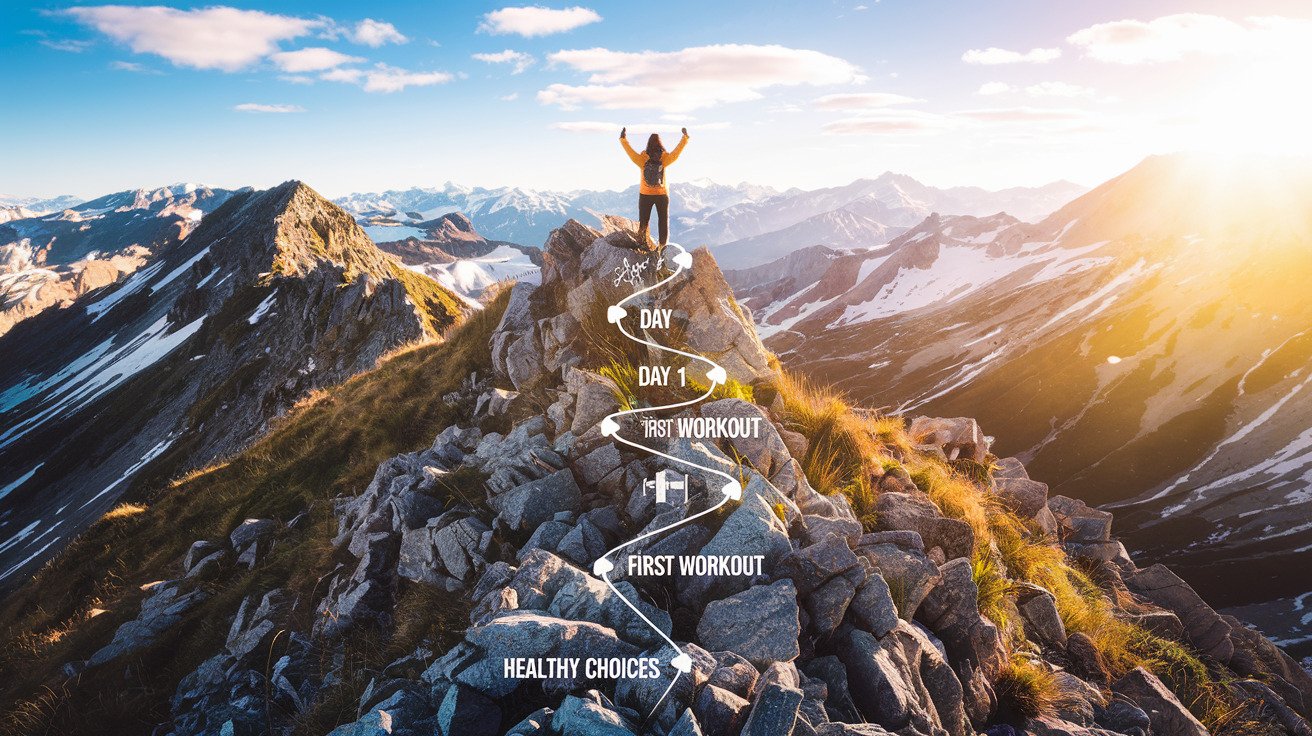Transforming My Life: A Journey of Significant Weight Loss
Embarking on a weight loss journey can be daunting, but it’s a path that has transformed my life in ways I never thought possible. Losing excess weight isn’t just about the number on the scale; it’s about adopting a healthier lifestyle that encompasses a balanced diet and regular physical activity.
For me, achieving a weight loss of 50 pounds in six months was a realistic goal, made possible by focusing on sustainable habits rather than quick fixes. This journey taught me the importance of listening to my body and making informed choices about my health.
My experience has shown that significant weight loss is achievable without extreme measures. By combining proper nutrition with consistent healthy habits, I’ve not only shed excess pounds but also improved my overall wellbeing.
Key Takeaways
- Achieving significant weight loss is possible with sustainable lifestyle changes.
- Focusing on long-term health benefits leads to more successful weight loss outcomes.
- Combining proper nutrition with regular physical activity is crucial for weight loss.
- Listening to your body and making informed health choices is key to successful weight loss.
- Healthy habits, not fad diets, lead to lasting weight loss results.
My Weight Loss Journey Begins
The journey to losing 50 pounds in 6 months started with a simple yet profound decision to take control of my weight. This decision was not made overnight; it was the culmination of a growing realization that my health and quality of life were being compromised by my weight.
Why I Decided to Make a Change
The pivotal moment that triggered my decision to embark on a serious weight loss journey was when I realized that my daily activities were becoming increasingly strenuous. Simple tasks like walking up the stairs or playing with my kids were leaving me breathless. I knew I had to make a change when I realized that my weight was not just affecting my physical health but also my mental well-being. I started by assessing my starting weight, body measurements, and identifying specific health markers I wanted to improve. For more information on safe weight loss practices, especially for postpartum women, I found valuable resources at Vibrant Voyage Hub.
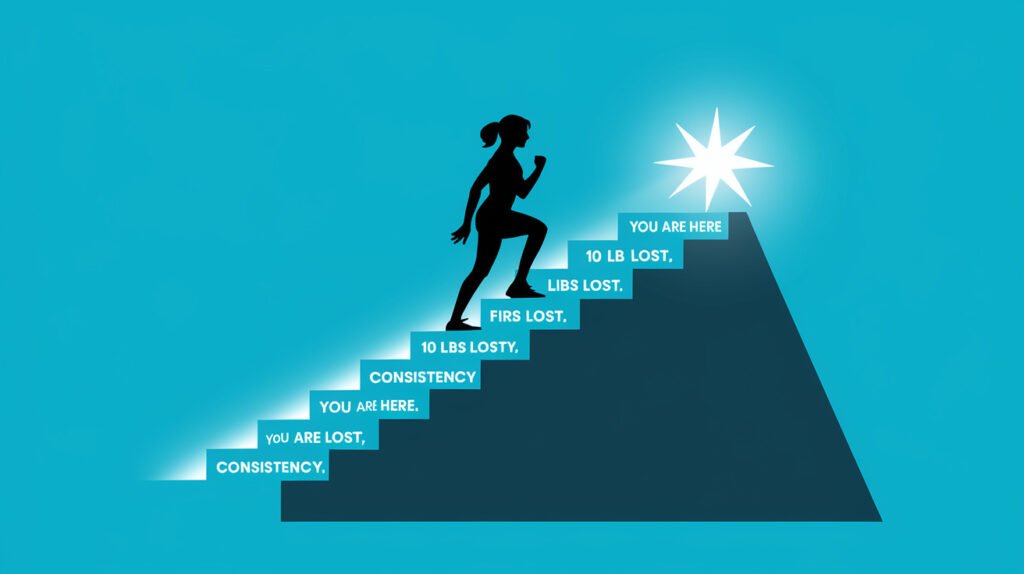
Setting My Initial Goals
Setting realistic goals is the first step in any successful weight loss journey. I aimed for a healthy and sustainable weight loss rate of 1-2 pounds per week, which meant losing 50 pounds in 6 months was a realistic goal. I set SMART (Specific, Measurable, Achievable, Relevant, Time-bound) goals, breaking down the 50-pound target into manageable monthly and weekly milestones. In addition to focusing on weight loss, I established complementary goals related to fitness improvements, energy levels, and sustainable lifestyle changes. This holistic approach helped me stay motivated and prepared for the journey ahead.
By setting clear goals and understanding the importance of a sustainable weight loss rate, I was able to mentally prepare myself for the challenges that lay ahead. I acknowledged that weight loss would require consistent effort and patience, and I accepted that setbacks were part of the process. This mindset helped me stay focused on my lifestyle changes rather than just the number on the scale.
Creating a Sustainable Calorie Deficit
I learned that to lose weight effectively, I needed to create a calorie deficit by adjusting my diet and exercise habits. This involved understanding my daily caloric needs and making conscious choices to consume fewer calories than I burned.
Understanding My Daily Caloric Needs
To start, I calculated my Total Daily Energy Expenditure (TDEE) to determine exactly how many calories my body needed each day for maintenance. This calculation helped me understand my baseline caloric requirements. I used an online TDEE calculator that considered my age, weight, height, and activity level to get an accurate estimate.
| Factor | Value |
|---|---|
| Age | 32 |
| Weight | 180 lbs |
| Height | 5’8″ |
| Activity Level | Moderate |
| TDEE | 2500 calories |
How I Reduced Calories Without Feeling Deprived
Rather than drastically cutting entire food groups, I focused on calorie density—choosing foods that provided more volume and nutrition for fewer calories. This approach helped me feel satisfied while in a calorie deficit. I incorporated more fruits, vegetables, and lean proteins into my meals.
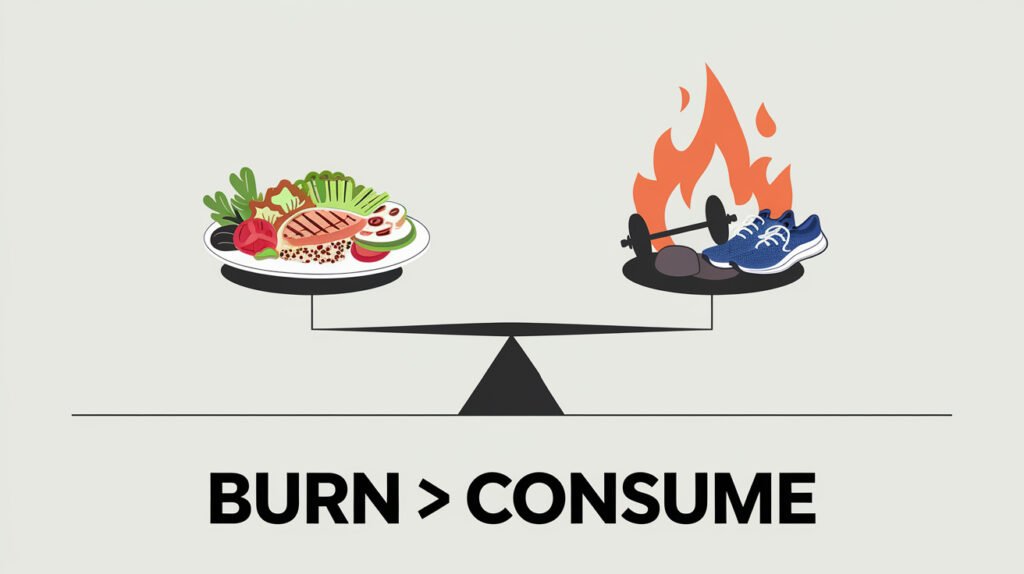
I also distributed my calories throughout the day, adopting a meal timing and frequency approach that helped manage hunger and energy levels. By balancing my calorie reduction with increased physical activity, I created a deficit through both consuming less and moving more, which optimized my weight loss results.
By creating a moderate calorie deficit of 500-750 calories per day, I achieved a sustainable weight loss of 1-2 pounds weekly. This rate was not only effective but also sustainable, helping me maintain my weight loss over time.
Transforming My Eating Habits
As I embarked on my weight loss journey, I realized that transforming my eating habits was crucial to achieving my goals. This transformation involved a significant shift towards whole, nutrient-dense foods that not only supported my weight loss but also improved my overall health.
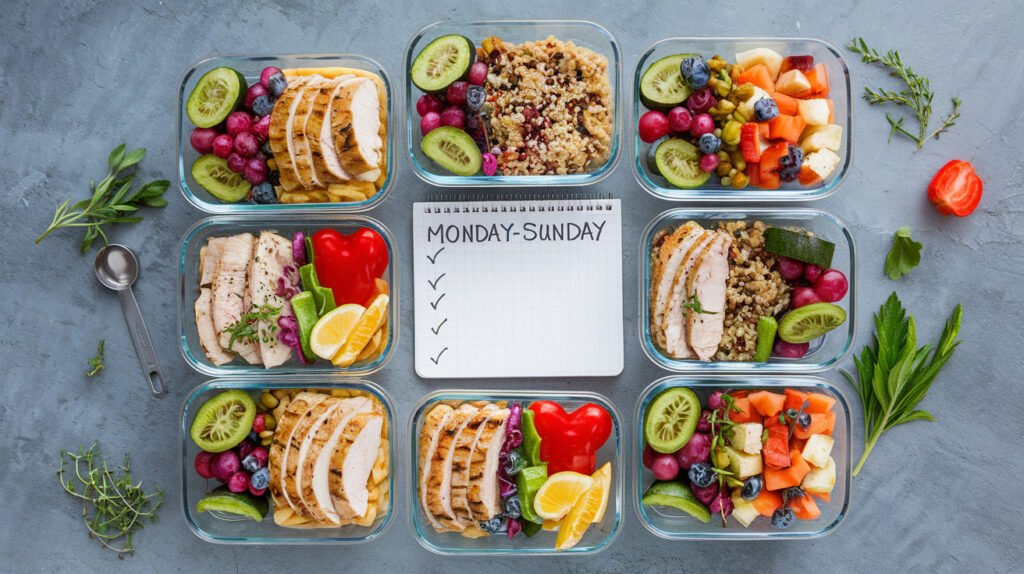
Nourishing My Body with Whole Foods
Focusing on whole foods was a game-changer for my diet. Whole foods, being minimally processed and rich in nutrients, became the cornerstone of my meals. I started incorporating more fruits, vegetables, lean proteins, whole grains, and healthy fats into my diet. This change helped me feel more satisfied and energized throughout the day.
- I prioritized vegetables like broccoli, spinach, and bell peppers for their nutritional value.
- Fruits such as berries, apples, and oranges were my go-to snacks.
- Lean proteins like chicken, fish, and tofu were essential for muscle preservation.
A Protein-Rich Meal Plan
To preserve muscle mass during weight loss and enhance satiety, I prioritized protein intake, aiming for 0.8-1g of protein per pound of body weight. My protein-rich meal plan included a variety of foods such as lean meats, fish, eggs, dairy, and plant-based options like legumes and tofu.
My daily protein sources included:
- Breakfast: Eggs or Greek yogurt with nuts.
- Lunch: Grilled chicken or fish with quinoa.
- Dinner: Lean beef or tofu with roasted vegetables.
Incorporating Fiber-Rich Foods
Increasing my fiber intake was another critical aspect of my diet transformation. I aimed for at least 25-30g of fiber daily through a mix of vegetables, fruits, legumes, and whole grains. This helped regulate my blood sugar levels and promoted digestive health.
Some of my favorite fiber-rich foods included:
- Legumes like lentils and chickpeas.
- Whole grains such as brown rice and whole wheat bread.
- Fruits like apples and berries.
By balancing my macronutrients and focusing on whole, nutrient-dense foods, I was able to create satisfying meals that supported both my weight loss goals and my energy needs for daily activities and exercise.
Portion Control Strategies That Worked for Me
As I continued my weight loss journey, I realized that controlling portion sizes was crucial to my success. I began to explore various strategies that would help me manage my calorie intake without feeling deprived.
Using Smaller Plates and Bowls
One of the simplest and most effective changes I made was switching to smaller plates and bowls. This trick made my portions appear larger, helping me consume fewer calories while still feeling satisfied. Research supports this approach, showing that people tend to eat less when they use smaller dinnerware.
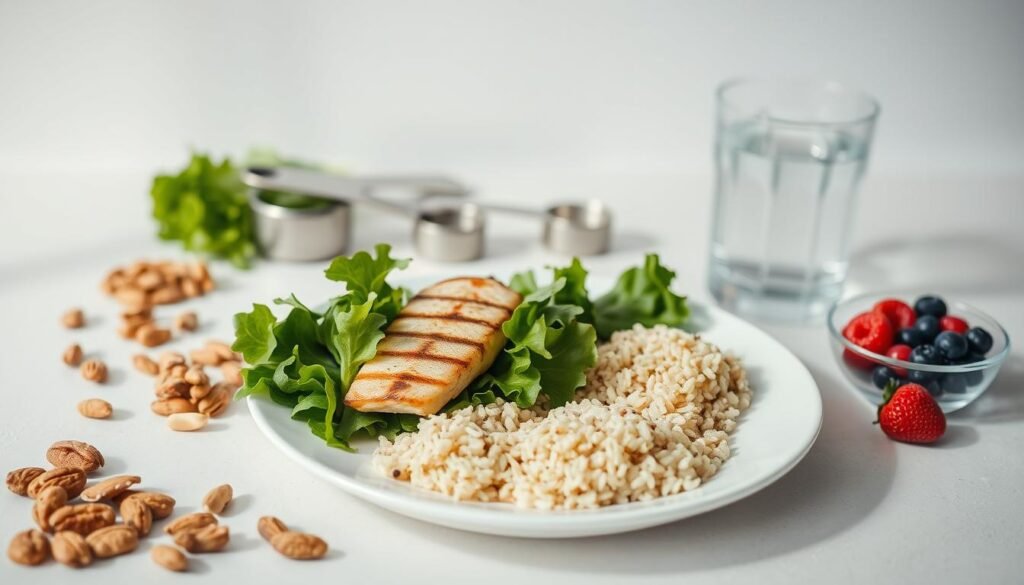
Mindful Eating Techniques I Practiced
In addition to using smaller plates, I adopted several mindful eating practices. I started eating slowly and chewing thoroughly, which allowed me to better recognize my hunger and fullness cues. I also eliminated distractions during meals, such as turning off the TV and putting away my phone. This helped me stay focused on my food and enjoy the experience.
To further enhance my portion control, I implemented the plate method, dividing my plate into sections: half for vegetables, quarter for protein, and quarter for complex carbohydrates. I also used visual cues and hand measurements to estimate appropriate portion sizes when eating out. For example, I used my palm to measure protein, my fist to measure carbs, and my thumb to measure fats.
| Food Group | Recommended Portion Size | Visual Cue |
|---|---|---|
| Protein | 3-4 ounces | Palm of hand |
| Complex Carbohydrates | 1/2 cup cooked | Fist |
| Healthy Fats | 1-2 teaspoons | Thumb tip |
By combining these strategies, I was able to develop a healthier relationship with food and achieve my weight loss goals. I learned to distinguish between physical hunger and emotional eating triggers, developing strategies to address emotional needs without turning to food.
“The key to successful weight loss is not about cutting out specific foods or following a particular diet, but rather about developing sustainable eating habits that you can maintain in the long term.”
How I Lost 50 lbs in 6 Months (Without Extreme Dieting)
My weight loss journey was a marathon, not a sprint, and it resulted in a significant loss of 50 pounds in just 6 months. This journey taught me the importance of patience and consistency in achieving sustainable weight loss.
My Weekly Progress Breakdown
Throughout my journey, I experienced varying rates of weight loss. The Centers for Disease Control and Prevention (CDC) recommend aiming to lose 1 to 2 pounds per week for a sustainable weight loss. On average, I lost approximately 2 pounds per week, which allowed me to maintain muscle mass and metabolic health while shedding fat.
My progress was not linear; there were weeks when I lost more weight, and others when my weight remained the same. For instance, during the first month, I lost around 8 pounds, but in the fourth month, my weight loss slowed down due to a plateau. Overall, my month-by-month breakdown showed a significant reduction in body weight, with some fluctuations.
Adjustments I Made Along the Way
To maintain progress, I made several adjustments to my nutrition and exercise plans. When I hit a plateau, I implemented strategic calorie cycling and modified my workout intensity. For example, I started incorporating a 7-day weight loss meal plan that helped me stay on track with my calorie deficit goals.
Beyond the scale, I noticed significant changes in my body measurements. I reduced several inches from my waist, hips, and other areas, indicating improvements in body composition. Additionally, I experienced numerous non-scale victories, including improved energy levels, better sleep quality, reduced joint pain, and enhanced mood and confidence.
My Exercise Routine Development
Crafting a sustainable exercise routine was a key component of my successful weight loss journey. As I progressed, I incorporated various forms of physical activity to burn calories and build muscle, which helped boost my metabolism.
Starting Small with Daily Walks
I began my exercise journey with simple daily walks, starting with 15 minutes a day. As my fitness level improved, I gradually increased the duration to 45-60 minutes daily. This progressive approach helped me establish a consistent routine.
Adding Strength Training to My Regimen
I incorporated strength training into my routine 2-3 times a week, focusing on compound movements like squats, lunges, and deadlifts. These exercises efficiently burn calories while building muscle mass, supporting my overall weight loss goals.
How I Found Exercises I Actually Enjoyed
To maintain consistency, I explored various forms of cardio exercise, discovering activities like swimming and cycling that I enjoyed. This made it easier to stick to my workout schedule. I also implemented a progressive overload strategy, gradually increasing exercise intensity and duration as my fitness improved.
Balancing rest and recovery was crucial in my exercise routine. I recognized that adequate recovery was essential for preventing injury and supporting continued progress in my weight loss journey. By combining regular physical activity with a balanced diet, I achieved significant weight loss and improved my overall health.
- Starting with daily walks and gradually increasing duration.
- Incorporating strength training to build muscle and boost metabolism.
- Finding enjoyable cardio exercises to maintain consistency.
- Implementing progressive overload to continue challenging my body.
- Balancing rest and recovery to prevent injury.
Staying Hydrated and Managing Cravings
Staying hydrated and managing cravings were crucial elements in my successful weight loss journey. Drinking enough water and controlling cravings played a significant role in my ability to achieve my goals.
Water Intake Strategies That Helped Me
I increased my water intake to 3-4 liters per day by using a few simple strategies. I carried a marked water bottle with me throughout the day, set reminders on my phone, and infused my water with natural flavors like lemon and mint to make hydration more appealing. These methods helped me stay on track and develop a consistent hydration habit.
Proper hydration supported my weight loss in several ways. It improved my metabolism, reduced false hunger signals, and enhanced my exercise performance and recovery. By drinking water before meals, I was also able to consume fewer calories without feeling deprived.
How I Handled Sugar and Salt Cravings
Managing sugar cravings was a challenge, but I found that incorporating natural sweeteners like honey and fruit into my diet helped. I also allowed myself occasional planned treats to prevent feelings of deprivation. This approach made it easier to stick to my weight loss plan.
To reduce salt cravings, I gradually decreased my sodium intake while increasing the use of herbs and spices to maintain flavorful meals. During high-craving moments, I used distraction techniques, made healthier substitutions, and identified emotional triggers that prompted cravings.
| Strategy | Benefit |
|---|---|
| Drinking water before meals | Reduced calorie intake |
| Increasing water intake | Improved metabolism |
| Using natural sweeteners | Managed sugar cravings |
| Reducing sodium intake | Decreased salt cravings |
The Role of Sleep and Stress Management
Through my journey, I learned that sleep quality and stress levels significantly influenced my weight loss progress. As I reflect on my experience, it becomes clear that these two factors played a crucial role in my overall success.
Improving Sleep Quality
I prioritized sleep quality and quantity, aiming for 7-8 hours of sleep each night. To achieve this, I implemented several sleep hygiene practices. First, I established consistent sleep-wake times to regulate my body’s internal clock. I also optimized my bedroom environment by ensuring it was dark, quiet, and cool, creating an ideal setting for restful sleep. Additionally, I developed a calming pre-sleep routine, which included activities like reading and meditation, to signal to my body that it was time to sleep.
Improved sleep directly supported my weight loss efforts by regulating hunger hormones like ghrelin and leptin, improving insulin sensitivity, and enhancing my metabolism. As a result, I found that I was better able to manage my calorie intake and make healthier food choices.
Stress-Reduction Techniques
To manage stress, I incorporated various techniques into my daily routine. These included meditation, deep breathing exercises, and spending time outdoors. I recognized that chronic stress could elevate cortisol levels, leading to increased hunger and cravings, which would undermine my weight loss efforts. By practicing these stress-reduction techniques, I was able to mitigate the negative impact of stress on my body.
I also made a conscious effort to identify my personal stress triggers and developed healthier coping mechanisms that didn’t involve emotional eating. By doing so, I was able to maintain my weight loss progress even during challenging times.
Tracking My Progress Beyond the Scale
To get a comprehensive view of my weight loss progress, I adopted a multi-faceted tracking approach. This involved monitoring various aspects of my health and fitness, not just my weight.
Non-Scale Victories I Celebrated
As I progressed, I celebrated numerous non-scale victories that significantly boosted my morale. These included reductions in clothing sizes, improvements in fitness performance, receiving compliments from others, and enhancements in my daily functioning. For instance, being able to walk further without getting tired or noticing improvements in my overall energy levels were significant milestones.
These non-scale victories were crucial as they provided tangible evidence of my progress, motivating me to continue with my weight loss plan. They also helped shift my focus from just the number on the scale to overall health and well-being.
Apps and Tools That Kept Me Accountable
I utilized several digital tools and apps to track my nutrition, exercise, sleep, and overall progress. These tools provided valuable insights into my habits and helped me stay accountable. For example, apps that tracked my daily food intake and exercise routines gave me a clear picture of my calorie deficit and physical activity levels.
Additionally, I kept a journal to track subjective measures like energy levels, mood, and hunger patterns. This helped me identify connections between my habits and how I felt physically and mentally, allowing me to make informed adjustments to my plan. By combining these tracking methods, I was able to monitor my weight loss journey comprehensively and make necessary adjustments along the way.
Overcoming Plateaus and Setbacks
As I progressed on my weight loss journey, I inevitably encountered plateaus that tested my resolve. Weight loss setbacks are normal and expected; even people steadily losing weight often hit a plateau after a few months.
When My Weight Loss Stalled
During my six-month journey, I experienced periods where my weight loss stalled despite continued effort. This was due to various physiological reasons, including a natural slowdown in metabolism as I lost weight.
To break through these plateaus, I employed several strategies. I practiced calorie cycling, changed my exercise routines, reassessed my portion sizes, and adjusted my macronutrient ratios. These adjustments helped me overcome the plateaus and continue making progress.
| Strategy | Description | Result |
|---|---|---|
| Calorie Cycling | Alternating daily calorie intake to boost weight loss | Increased weight loss rate |
| Changing Exercise Routines | Varying workouts to avoid plateaus and challenge muscles | Improved overall fitness and weight loss |
| Reassessing Portion Sizes | Adjusting food portions to maintain a calorie deficit | Enhanced weight loss progress |
How I Pushed Through Difficult Moments
There were times when I faced setbacks, such as overeating at social events or missing workouts due to illness. To handle these situations, I focused on quickly returning to my plan rather than allowing temporary slips to derail my progress.
“Success is not final, failure is not fatal: It is the courage to continue that counts.” – Winston Churchill
To maintain motivation during challenging periods, I revisited my original goals, focused on non-scale progress, and visualized my desired outcomes. I also used data from my tracking systems to make evidence-based adjustments to my plan when results slowed.
Building My Support System
Building a support system was a crucial step in my successful weight loss story. Having people around me who understood and supported my goals made a significant difference in my journey. A strong support system can provide motivation, accountability, and emotional support when faced with challenges.
One of the key elements of my support system was finding accountability partners. I was fortunate to find someone with similar weight loss goals who checked in regularly, celebrated my victories, and helped me problem-solve when challenges arose.
Finding Accountability Partners
Having an accountability partner was instrumental in keeping me on track. We shared tips, progress, and challenges, which helped us stay motivated. This partnership provided an added layer of motivation, as we encouraged each other to reach our goals.
Some of the ways my accountability partner helped me include:
- Regular check-ins to track progress
- Celebrating milestones and successes
- Providing support during difficult times
Online Communities That Inspired Me
In addition to my personal accountability partner, I found inspiration and support through online communities and forums. These platforms provided a wealth of information, advice, and encouragement from individuals who were on similar weight loss journeys.
Some of the benefits I derived from these online communities included:
- Practical advice on diet and exercise
- Inspiration from success stories
- A sense of belonging to a community with shared goals
I also learned how to handle unsupportive or negative individuals by setting boundaries and limiting my exposure to those who didn’t respect my health goals. Furthermore, I utilized professional resources like consultations with a registered dietitian and personal trainer to receive expert guidance tailored to my specific needs.
Conclusion: Maintaining My Weight Loss and Looking Forward
After shedding 50 pounds in 6 months, I’ve learned that the real challenge lies in sustaining the results. Maintaining weight loss requires a continued commitment to healthy eating and regular exercise. I’ve adjusted my calorie intake and exercise routine to meet my new needs, focusing on sustainable habits rather than quick fixes.
My journey has transformed my relationship with food, exercise, and my body, shifting from appearance to overall health and wellbeing. I’ve experienced numerous benefits, including improved energy levels, better sleep quality, and a reduced risk of chronic diseases.
To others on a similar journey, I emphasize that sustainable results come from consistent healthy habits, not extreme measures. Everyone’s path is unique, and it’s essential to find a lifestyle that works for you.
FAQ
What is a sustainable rate of weight loss?
How can I create a calorie deficit without feeling deprived?
What role does protein play in weight loss?
How can I manage sugar cravings?
What are some effective stress-reduction techniques for weight loss?
How can I stay motivated during a weight loss journey?
What are some common mistakes to avoid during weight loss?
How can I maintain my weight loss over time?
editor's pick
latest video
news via inbox
Nulla turp dis cursus. Integer liberos euismod pretium faucibua

